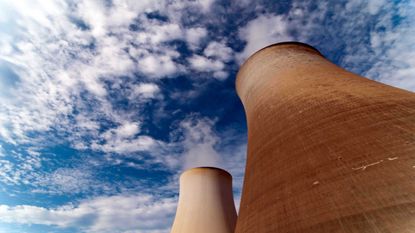New Emissions Limits to be Introduced: Kiplinger Economic Forecasts
Emissions limits are still many years away but there is doubt whether industries will be ready.


The way businesses and industries are regulated affects people and the economy. So our hugely experienced Kiplinger Letter team will keep you abreast of the latest regulatory developments and forecasts (Get a free issue of The Kiplinger Letter or subscribe). You will get all the latest news first by subscribing, but we will publish many of the forecasts online a few days afterward. Here’s the latest…
New emissions limits for fossil fuel-fired power plants are on the way.
The centerpiece of the Biden administration’s proposal is technology — specifically, carbon capture and storage, which is one of many ways regulators say that utilities can meet new emissions targets for gas and coal-fired power plants.

Sign up for Kiplinger’s Free E-Newsletters
Profit and prosper with the best of expert advice on investing, taxes, retirement, personal finance and more - straight to your e-mail.
Profit and prosper with the best of expert advice - straight to your e-mail.
The Environmental Protection Agency also includes “co-firing” on its list of ways for power plants to comply. This basically involves burning a cleaner fuel alongside the main one, such as natural gas with coal, or hydrogen with natural gas.
Initial requirements would not kick in until 2030 for coal-fired power plants and 2032 for natural-gas plants and would vary based on several factors, including the size of a plant, how often it runs, its expected lifespan and whether it is new or existing.
Will plants be able to meet these targets?
The goal is to give tech time to catch up with the administration’s goals. But it’s still unclear whether carbon capture and green hydrogen will be ready when that time comes. For example, only two commercial coal power plants now supplying the U.S. grid employ carbon-capture tech. No gas-powered ones do.
Critics say the rules would increase electricity costs and hurt grid reliability by forcing more retirements of dispatchable grid resources — those that can more easily adjust their power output based on consumer demand, which includes gas and coal.
The Biden administration expects retail electricity prices to increase by 0.2% by 2035, fueled by utilities spending at least $10 billion to meet the proposed requirements. Also unclear: whether these regs could survive the inevitable legal challenge.
This forecast first appeared in The Kiplinger Letter. Since 1923, the Letter has helped millions of business executives and investors profit by providing reliable forecasts on business and the economy, as well as what to expect from Washington. Get a free issue of The Kiplinger Letter or subscribe.

-
-
 What’s in DeSantis’ $1.3 Billion Florida Tax Relief Bill?
What’s in DeSantis’ $1.3 Billion Florida Tax Relief Bill?DeSantis' $1.3 billion tax relief bill extends sales tax holidays and makes other tax cuts. Here's what you can buy tax-free — and when.
By Katelyn Washington • Published
-
 Letter from the Senior Digital Editor: Celebrating Pride
Letter from the Senior Digital Editor: Celebrating PrideKiplinger senior digital editor Alexandra Svokos writes at the start of Pride Month.
By Alexandra Svokos • Published
-
 Mixed Bag on Business Costs as Manufacturing Costs Fall, Oil is Headed Up: Kiplinger Economic Forecasts
Mixed Bag on Business Costs as Manufacturing Costs Fall, Oil is Headed Up: Kiplinger Economic ForecastsEconomic Forecasts Mixed bag on business costs as manufacturing and gas prices fall, but oil is up: Kiplinger Economic Forecasts
By David Payne • Published
-
 Text-Generating AI Faces Major Legal Risks: Kiplinger Economic Forecasts
Text-Generating AI Faces Major Legal Risks: Kiplinger Economic ForecastsEconomic Forecasts Major legal risks to text-generating artificial intelligence: Kiplinger Economic Forecasts
By John Miley • Published
-
 Farmers Face Lower Costs, Greater Weather Risks: Kiplinger Economic Forecasts
Farmers Face Lower Costs, Greater Weather Risks: Kiplinger Economic ForecastsEconomic Forecasts Farmers Face Lower Costs, Greater Weather Risks: Kiplinger Economic Forecasts
By Matthew Housiaux • Published
-
 Shortages Galore Threaten Ability to Power, Heat and Cool Our Homes: Kiplinger Economic Forecasts
Shortages Galore Threaten Ability to Power, Heat and Cool Our Homes: Kiplinger Economic ForecastsEconomic Forecasts Shortages of transformers, heat pumps and air conditioning units are threatening our ability to power, heat and cool our homes.
By Matthew Housiaux • Published
-
 Safety Rights for Key California Workers Could Be Tightened: Kiplinger Economic Forecasts
Safety Rights for Key California Workers Could Be Tightened: Kiplinger Economic ForecastsEconomic Forecasts Safety Rights for Key California Workers Could Be Tightened: Kiplinger Economic Forecasts
By Matthew Housiaux • Published
-
 Car Makers Look To Cut the Cost of Recalls: Kiplinger Economic Forecasts
Car Makers Look To Cut the Cost of Recalls: Kiplinger Economic ForecastsKiplinger Economic Forecasts Faulty software costs car manufacturers $500m in recalls. What are they turning to and what could that mean for you?
By Letter Editors • Published
-
 Tablet Sales Slump After Pandemic Surge: Kiplinger Economic Forecasts
Tablet Sales Slump After Pandemic Surge: Kiplinger Economic ForecastsEconomic Forecasts Tablet sales slump after the pandemic surge, but it’s not all bad news for the sector: Kiplinger Economic Forecasts
By Letter Editors • Published
-
 White House Probes Tracking Tech That Monitors Workers’ Productivity: Kiplinger Economic Forecasts
White House Probes Tracking Tech That Monitors Workers’ Productivity: Kiplinger Economic ForecastsEconomic Forecasts White House probes tracking tech that monitors workers’ productivity: Kiplinger Economic Forecasts
By Matthew Housiaux • Published









